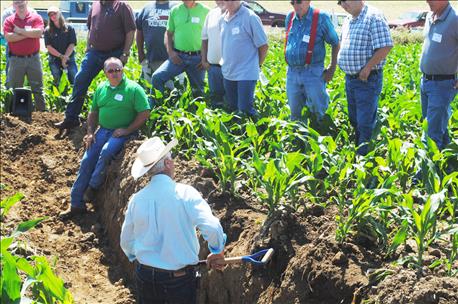
I recently attended another stop along the Nebraska leg of No-till on the Plains’ popular Whirlwind Expo. I’ve attended four similar stops over the years at varied sites. My first time was in 2012 at Nick Keller’s farm near Spencer. We all recall what the summer of 2012 was like, particularly in Boyd County. That’s why it was so eye-opening for me to see that Nick’s dryland no-till cornfield was the only green dryland field around in July that year.

IN THE SOIL: Ray Ward (in the pit), president of Ward Laboratories, is a mainstay at no-till events. He continues to push discussions within the no-till community on the use of all kinds of methods to improve soil microbe activity and soil health.
Since then, it seems every year there is rapid progression made for no-tillers. Adoption and adaption are taking place at an ever-quickening pace. In subsequent years, more discussion at each expo was given to soil microbes and the importance of feeding activity in the soil. Two years ago at the Kathol farm near Hartington, and again last year at the Kaup farm near Stuart, most of the discussions in the field were centered on timing and adaption of cover crops into the no-till system. This is still the hot topic, as more no-tillers figure out their crop rotations and timing of seeding cover crops, and “feeding microbes the good stuff,” as Ray Ward likes to say. Ward has certainly pushed no-till discussions to get farmers thinking about how their practices impact soil health.
But this year, another step has been taken as no-tillers continue to improve their methods to get the most out of their system and to get the ultimate in soil health improvements. At this year’s stop, discussions went on to companion crops and pulse crops, with some questions along those lines being fielded by Keith Berns of Green Cover Seed.
I find it interesting how fast farmers are adopting soil health measures, and doing it within the no-till system. It is a testament to the philosophy of many producers today when it comes to saving soil to improve their crops.
The benefits are many. Water quality, soil health, profitability, the environment, the land and the people inhabiting it are the benefactors of this work. No-tillers will tell you that there is so much work to do and that there are so many things we don’t know — even with systems like cover crops, companion and pulse crops, which have been around for centuries. The cool part is that we are now gaining new research that can quantify the benefits of these practices. That will only bring more admirers and more producers who will want to figure out ways to incorporate these methods into their own farming operations. It is fun to see this progression, and it will be fun to watch as we continue to learn more.
About the Author(s)
You May Also Like






